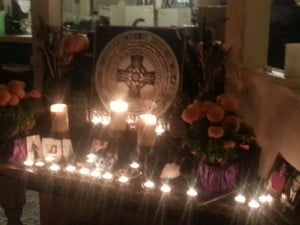As is well known in our community, the term “Pagan” was not initially a religious one, and when it took on a religious meaning, it was in contrast to “Christian.” Over the years it has gradually solidified to refer to religions that are not Abrahamic and not Buddhist. Hindus seem to go in and out depending on the writer and the context. So at first, it seems to be a catch-all in historical terms, a kind of linguistic wastebasket into which religions not granted equal status with the “great” ones of the Axial Age can be tossed and forgotten about.
Despite this history of the term, it does describe something of greater antiquity than any other religion. We modern Pagans inherit a truly ancient and very honorable tradition.
So far as we know, all societies originally grew out of groups of hunter-gatherers, and (again, so far as we know) their spiritual beliefs and practices were in harmony with Pagan religion’s defining characteristics and central story. Certainly existing hunter-gatherer societies appear to be. In them, shamans and often others experience the world as inspirited and alive. They regard their relationships with the other-than-human world in ethical as well as instrumental terms, as would be expected for people enmeshed in relations with others with whom they need to live in harmony. From this perspective material things such as fish, bears, and birds, and even rocks and rivers, have spiritual dimensions that must be taken into account if we are to live wisely. Spirits can help or hurt us. Living appropriately in this world is the primary necessity for a good life. In his study of such societies, Hugh Brody observes, “Everything about the hunter-gatherer system is founded on the conviction that home is already Eden, and exile must be avoided” (86). As we will see, Brody’s point will be a crucial one.
The religions of agricultural societies grew from these Pagan roots, modified and reinterpreted over time by changing relations between people. These shifts arose from their new ways of life and also by their changing relationship towards nature. For example, so far as I know, hunter-gatherers have no word for “weed,” whereas agricultural societies do. This difference signals a shift in how relationships are experienced, becoming more uncertain and adversarial and requiring greater control. In addition, hunter-gatherer societies can often be extremely complex, but they are not very hierarchical. Agriculture made it far easier to have large communities and eventually cities. Once cities arose, great inequalities in wealth followed almost as a matter of course. These conditions encouraged increasingly steep hierarchies. Farmers themselves undermined their initial relative equality as growing population led to smaller farms. Small size led to greater vulnerability to bad luck or bad decisions, and bad luck forced some to become subordinate to others. This is the central contradiction of agricultural societies being free societies.
This contradiction took on unusual shape in the European conquest of North America. The United States, especially outside major slave-owning regions, was unique in that a largely literate population had entered into vacated or seized land, taking it over without having to install an aristocracy or strong military to do so. Disease was more effective at Indian removal, and temporary militias could finish the job.
Out of this unique situation eventually arose a society of small farmers, democratic town meetings, and the seeds of larger scale democratic government. Many of our Founders appreciated the importance of small-scale land ownership and independence as necessary for sustaining a free agricultural society. The wisest of them knew it was also intrinsically transient. Thomas Jefferson wrote that one important reason for making the Louisiana Purchase was to put off the rise of despotism. The enormous expansion of new farmland made possible a few more generations able to live in freedom.
The rise of modern economies changed all that, but that is another paper. Back to agriculture and Pagan religion.
As hierarchies arose in the human world, hierarchy also shaped how people conceived the world of Spirit. For example, Sumerians believed humans needed to serve the gods through manual labor because the gods themselves were unwilling to labor. Hunter-gatherers would have found this view incomprehensible.
These changes took place slowly, with no decisive break. The classical Greeks were far from being hunter-gatherer societies. But we can observe an increasing distancing from the living world in their history, as the Gods became more abstract, their depictions more human, and the world more passive. While divine hierarchies were well established, and goddesses increasingly subordinated, as late as Homer the world was still alive “all the way down” and a prayer by Odysseus to a river for help could be answered by the river (Odyssey, Bk. 5).
By Socrates’ time, philosophy increasingly focused on the human world alone, and the natural world was mostly silent. Even so, in the Phaedrus there is a little-discussed account of Socrates being possessed by a spirit, followed by his daemon correcting him. Further, it is clear from the dialogue that there are those more gifted than Socrates at connecting with spirits (Phaedrus. 237a-241d). Yet little attention seems to have been paid to the implications of these events, and whatever attention was paid, it surely declined over time. As the centuries passed, educated Pagans focused less on the living world and more on more abstract conceptions of deity. The Epicureans went so far as arguing the Gods had nothing to do with us. But there was no fundamental break with the past in this prolonged transition. For example, the Greek goddess Artemis was likely once a bear goddess and in Athens, at the height of her power, little girls still dressed up as bears in a ritual probably extending back into the Neolithic.
Even so, at a lay level and towards the end of classical Paganism (even among the NeoPlatonists), phenomena we today would call spirit incorporation, drawing down the moon, and channeling were well known. The NeoPlatonists called practices like these “Theurgy.” This type of practice never disappeared. But for the NeoPlatonists, the focus was no longer the inspirited world, but dimensions of Spirit closer to its Source.
Decisive breaks did come. The most decisive took place over an extended period sometimes called the Axial Age. The most radical of them all was the rise of a monopolistic monotheism that saw itself as hostile to earlier religions and deities. This probably first happened in Egypt during the Pharaoh Akhenaton’s rule. I think it no coincidence that a god of absolute rule was promoted by a Pharaoh claiming divine guidance and absolute worldly rule. Such extreme hierarchies were inconceivable in hunting-gathering societies and were actively hostile to the monism that was a common belief among educated circles in the pre-monotheistic Pagan world.
A much less radical break occurred in South Asia with the rise of enlightenment-oriented religions. They held human life was fundamentally flawed in some sense, and a way out of our predicament needed to be found. Enlightenment-oriented traditions defined themselves against earlier practices that they argued had become spiritually dead or corrupted. Because these traditions often arose out of pre-existing Pagan traditions, the lines distinguishing them can be blurry, as is most clear within Hinduism.
Paganism is defined by a story and patterns of belief that fit that story. Hinduism is defined geographically. Consequently they overlap, but neither is encompassed within the other. The blurry line is where a Hindu hopes for a better incarnation but has no focus on attaining enlightenment or getting close to it in this life.
Buddhism arose later and is perhaps the ‘purest’ expression of an enlightenment tradition, but it also often incorporated existing Pagan traditions much more explicitly than did the Catholic Church, and at the level of popular practice it is, in most respects, often Pagan. Again, the lines blur.
Some years ago I met and worked with a Naxi priest from a part of China close to Tibet. I was fascinated to see that their religious implements, which were on loan to the Whitman College museum, were similar to those of Tibetan Buddhism. I asked him if he were a practitioner of Bon. He said, “No, the Bon have been too influenced by Buddhism.” He told me that the Naxi still practiced their indigenous religion. When he later attended a healing ritual I conducted, he was excited, and he told the anthropolgist who had invited him to this country, “There’s shamanism in America!” When I learned more about traditional Naxi beliefs, I found they were remarkably close to central Gardnerian tenets and had no resemblance at all to Buddhism. The priest spoke no English, and so far as I know, he had never left his region before his visit. If his description of Tibetan Bon is correct, we have a continuum: Naxi – Bon – Vajrayana (Tibetan) Buddhism.
“Post-Axial” monotheist and enlightenment religious traditions (unlike the Naxi) agreed the world was in some basic sense unsatisfactory. Human life was doomed to misery and suffering, and we needed a way out. That way might be salvation, it might be enlightenment and release from the wheel of rebirth. More than before, individuals were separated from being at home in the world to considering it alien, a “vale of tears,” and looking towards a time when they no longer had to be a part of it. In marked contrast to hunter-gatherers, Eden was not home. Compared to the Pagan story, this perspective unavoidably isolates the person from the world. However, even in Pagan traditions elements of this change in perspective can be observed.
This same change in perspective also began separating individuals from their communities. To the best of my knowledge, its most extreme form is in many Protestant Christian traditions, but it can be seen in the enlightenment traditions as well. A person was saved or attained enlightenment on one’s own. Protestantism ultimately led to the extreme individualism of many Americans. This alienation was implicit in all religions that saw the world as inherently flawed and individuals needing to find escape from it.
For hunting and gathering peoples, the ideal is to live in harmony with the great currents of existence. Later Pagan traditions laid less emphasis on this ideal, reflecting the often miserable quality of life most people lived in large Pagan agricultural societies such as Rome. These changes took place slowly and did not directly contest the basic assumptions of Pagan spirituality; rather, they shifted the context in which people tried to apply their religion. As societies differentiated, people changed their rituals, rethought their deities, redefined their relations to nature, and to one another. But all had roots in their pre-agricultural past.
When I write about “Pagan religion,” I am writing about religions with the oldest roots of all. That is also one reason I argue Pagan religion is at its core a “nature religion.” We are part of a tradition that first recognized and encountered the Sacred in and through nature and never really stopped doing so. Those today who stop thinking about Paganism when they get back to Greece or some equivalent culture stop too soon. Those traditions themselves had historical roots that shared similar beliefs at a more general level. And that is why little Athenian girls dressed up as bears.















